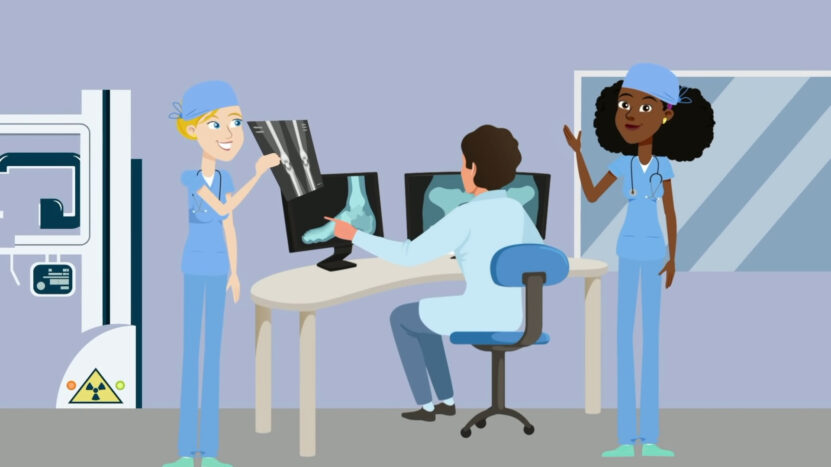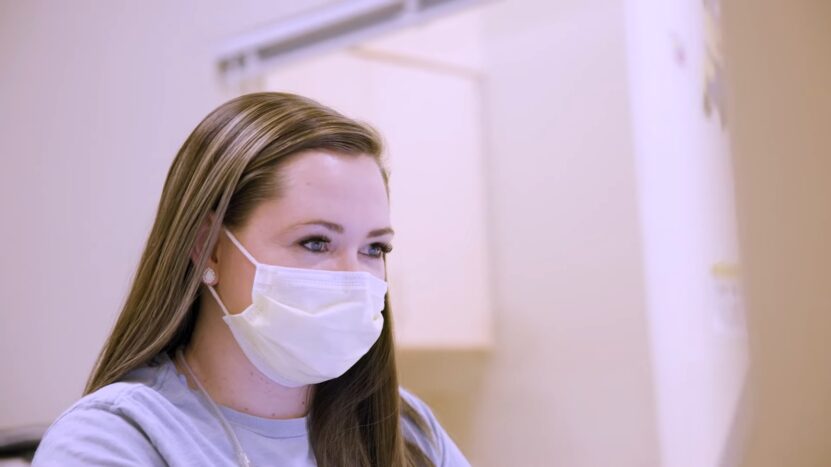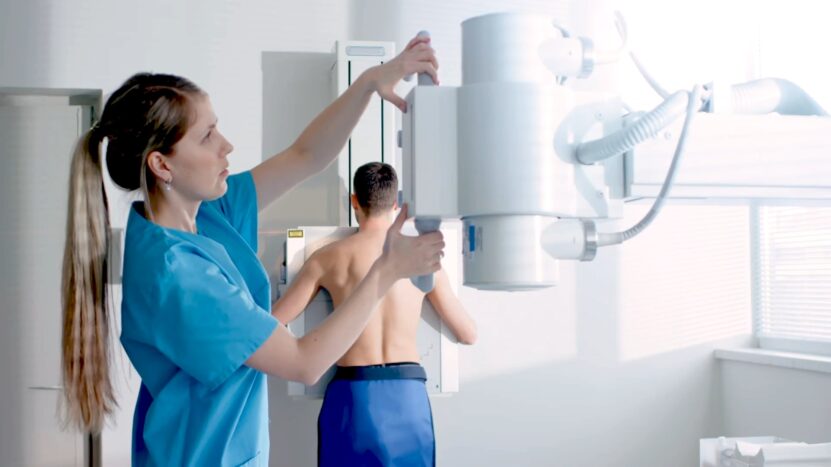Radiology technicians are vital members of the healthcare team, specializing in diagnostic imaging. This profession requires a unique blend of technical expertise, continuous learning, and interpersonal skills.
Key Takeaways
- Education and Certification: Start with a high school diploma, complete an accredited radiology technology program, and pass a certification exam.
- Career Opportunities: Diverse roles await in this field, with possibilities for advancement into supervisory and educational positions.
- Compensation and Benefits: Competitive salaries and the opportunity to make a significant impact on patient care make this a rewarding career choice.
Required Education
A high school diploma or equivalent is the first step. The next crucial phase is completing an accredited radiology technology program, which typically involves both classroom learning and clinical training.
These programs cover a broad range of topics, including human anatomy, radiographic imaging techniques, patient care, and radiation safety. Education in this field is not just about acquiring technical skills; it’s about understanding the role of imaging in diagnosis and treatment, which is crucial for effective patient care.
Certification is Also Important
Certification is a key milestone in this career path. After completing an educational program, aspiring radiology technicians must pass a certification exam. This exam, conducted by recognized bodies like the American Registry of Radiologic Technologists (ARRT), assesses the candidate’s knowledge and skills.
Certification is more than just a credential; it’s a testament to a technician’s commitment to professional standards and quality patient care. It also opens doors to better job opportunities and is often a requirement for employment in many healthcare facilities.
| Country/Region | Education Requirements | Certification Requirements |
|---|---|---|
| United States | Associate’s or Bachelor’s degree in Radiography or related field | Certification by the American Registry of Radiologic Technologists (ARRT) |
| United Kingdom | Bachelor’s degree in Radiography | Registration with the Health and Care Professions Council (HCPC) |
| Canada | Diploma or Bachelor’s degree in Medical Radiation Technology | Certification by the Canadian Association of Medical Radiation Technologists (CAMRT) |
| Australia | Bachelor’s degree in Medical Radiation Science | Registration with the Medical Radiation Practice Board of Australia |
| Germany | State-recognized training in Radiology Technology (usually 3 years) | State examination for formal recognition |
Career Opportunities

A career as a radiology technician can lead to various exciting and rewarding opportunities. Entry-level positions may involve working as a general radiographer, but with experience and further education, technicians can specialize in areas like MRI, CT, mammography, or nuclear medicine. Each of these specialties requires additional training and certification, offering technicians a chance to focus on areas that interest them most.
Advancing in Your Career
The career trajectory for radiology technicians can include roles like shift supervisor, chief radiologic technologist, or even positions in education and administration, such as clinical instructors or program directors.
These advanced roles often require additional skills in management, education, and leadership. Advancement in this field is closely tied to continuous learning, professional development, and the willingness to take on new challenges and responsibilities.
Job Market Growth
The demand for radiology technicians is driven by several factors, including an aging population and the consequent increase in medical conditions that require diagnostic imaging. Advances in technology also play a role, as new imaging techniques and equipment create a need for skilled technicians.
Projected Growth and Opportunities
The job outlook for radiology technicians is promising. The Bureau of Labor Statistics predicts a growth rate of about 6% between 2021 and 2031, which is on par with the average for all occupations.
The growth translates into thousands of new job openings annually. The field’s resilience in the face of economic fluctuations also makes it an attractive career choice for those seeking stability and long-term growth potential.
Developing a Skill Set
| Skills Required for Radiology Technicians | |
|---|---|
| Technical Skills | |
| 1 | Operating imaging equipment (X-ray, CT, MRI machines) |
| 2 | Understanding of radiation safety and protection measures |
| 3 | Knowledge of human anatomy and physiology |
| 4 | Ability to position patients correctly for imaging |
| 5 | Familiarity with clinical processes and procedures |
| Soft Skills | |
| 1 | Effective communication with patients and healthcare team |
| 2 | Empathy and patience when dealing with anxious patients |
| 3 | Teamwork and collaboration skills |
| 4 | Critical thinking and problem-solving abilities |
| 5 | Time management and the ability to handle a fast-paced work environment |
Radiology technicians need a deep understanding of imaging techniques and technology. This includes knowledge of how to operate various imaging equipment like X-ray machines, CT scanners, MRI machines, and understanding the principles of radiation safety. Proficient use of these technologies is crucial for producing clear and accurate images, which are essential for diagnosis.
The Importance of Soft Skills
In addition to technical skills, radiology technicians must also possess strong soft skills. Effective communication is paramount for interacting with patients, many of whom may be anxious about the imaging process.
Technicians also need to work collaboratively with other healthcare professionals, requiring teamwork and interpersonal skills. Other important soft skills include critical thinking for problem-solving and decision-making, especially when it comes to patient positioning and image interpretation.
Continuous Learning

Radiology technology is a rapidly evolving field, with continual advancements in imaging techniques and equipment. To provide the best patient care and remain competitive in the job market, radiology technicians must commit to lifelong learning. This includes participating in continuing education programs, attending workshops and conferences, and staying abreast of the latest research and developments in the field.
Continuing Education Should be in Focus
Continuing education is often a requirement for maintaining certification. It allows technicians to learn about new imaging modalities, update their skills, and deepen their understanding of complex medical conditions. This ongoing education not only enhances a technician’s capabilities but also contributes to their professional growth and job satisfaction.
Workplace Dynamics

Radiology technicians often work in fast-paced environments such as hospitals, outpatient clinics, and diagnostic imaging centers. They must be adept at managing a heavy workload, which includes preparing and positioning patients, operating imaging equipment, and maintaining detailed records. The ability to multitask and handle stressful situations calmly is essential.
Collaboration with Other Professionals
Radiation safety is a top priority in this field. Technicians must follow strict protocols to protect themselves, their colleagues, and their patients from unnecessary exposure. They also work closely with radiologists and other healthcare professionals, playing a critical role in the diagnosis and treatment process. This collaboration requires not only technical expertise but also the ability to communicate effectively and work as part of a team.
Compensation and Benefits
| Location | Average Salary | Benefits |
|---|---|---|
| California, USA | $85,000 – $90,000 | Health insurance, retirement plans, paid leave, potential bonuses |
| Texas, USA | $60,000 – $65,000 | Health insurance, retirement benefits, paid vacation |
| New York, USA | $70,000 – $75,000 | Comprehensive health insurance, retirement plans, paid holidays |
| United Kingdom | £30,000 – £40,000 | NHS benefits, pension schemes, maternity/paternity leave, training opportunities |
| Canada | CAD 60,000 – CAD 70,000 | Health benefits, retirement savings plans, paid leave, professional development support |
| Australia | AUD 65,000 – AUD 80,000 | Superannuation, health insurance, annual leave, professional development allowances |
The national average salary for a radiology technician in the United States is approximately $79,115 per year, but this can vary based on location, experience, education, and specialization. In addition to competitive salaries, many radiology technicians enjoy benefits like health insurance, retirement plans, and opportunities for overtime pay.
The Satisfaction of Making a Difference
Beyond the financial rewards, a career as a radiology technician offers the satisfaction of making a significant impact on patient care. Technicians play a crucial role in the diagnostic process, which is fundamental to effective treatment and patient outcomes. This sense of purpose and the opportunity to contribute to the well-being of others is a significant benefit of this profession.
FAQs

Who is qualified to read an MRI?
An MRI (magnetic resonance imaging) is a type of medical imaging that uses magnetic fields and radio waves to produce detailed images of the body’s internal structures. MRI scans are usually interpreted by radiologists, who are medical doctors who specialize in diagnosing and treating diseases and injuries using medical imaging. However, other medical professionals, such as neurologists, cardiologists, or orthopedists, may also read MRI scans related to their specific fields of expertise.
Where is the best place to study radiology?
Radiology is the medical discipline that uses medical imaging to diagnose and treat diseases within the bodies of animals, including humans. To become a radiologist, you need to complete a medical degree and a residency program in radiology, which may take up to six years. Some of the best medical schools for radiology in the world are Harvard University, New York University (Grossman), Johns Hopkins University, University of California–San Francisco, and Duke University.
Is a Radiologist a doctor in the USA?
Yes, a radiologist is a doctor in the USA. A radiologist is a medical doctor who has completed the appropriate post-graduate training and interprets medical images, communicates these findings to other physicians using a report or verbally, and uses imaging to perform minimally invasive medical procedures. To become a radiologist in the USA, you need to graduate from an accredited medical school, pass the United States Medical Licensing Examination (USMLE), and complete a residency program in radiology.
Where is the best place to work as a Radiologist?
The best place to work as a radiologist may depend on your personal and professional preferences, such as the salary, the cost of living, the demand for radiologists, the work-life balance, and the career opportunities. Some sources suggest that some of the best states for radiologists in the USA are Wisconsin, Minnesota, California, Arizona, and Nevada, based on factors such as the average salary, the cost of living, and the concentration of radiologists. However, you may also consider other factors, such as the quality of health care, the climate, the culture, and the lifestyle of each state.
Summary
A career as a radiology technician is both challenging and rewarding. It offers a unique blend of technical skills, continuous learning, and the opportunity to make a significant impact in the healthcare sector. With promising job prospects and the chance to specialize in various areas of imaging, it’s a career path that offers both stability and growth potential.
